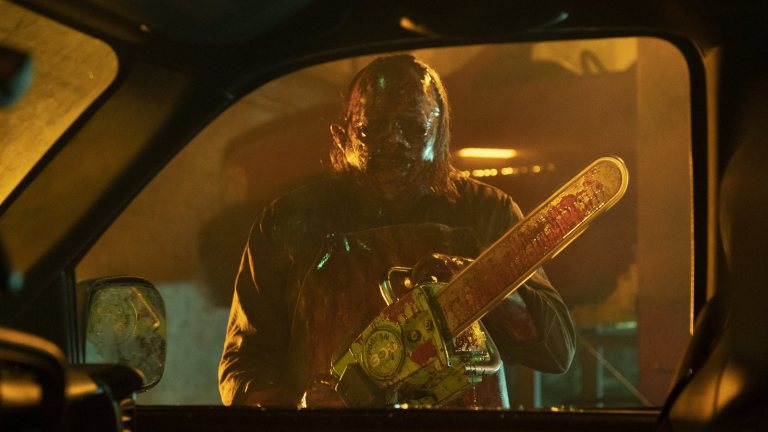Texas Chainsaw Massacre Ending Is Unexplainable
Can someone tell us how Leatherface is able to do what he does in the new Texas Chainsaw Massacre?

There are so many things wrong with the new Netflix movie Texas Chainsaw Massacre, a dull, pointless, mean-spirited, and cynical cash-grab so unimaginative that the filmmakers couldn’t even be bothered to come up with at least a variation of the title. But surely the film’s ending is one of the shabbiest and dumbest aspects of this entire fiasco.
To recap: entrepreneurs Dante (Jacob Latimore) and Melody (Sarah Yarkin) have raised enough money from investors to buy an entire abandoned town in Texas with the goal of turning it into some sort of new hipster utopia–Williamsburg South, you might say. But our protagonists didn’t cross all their t’s and dot all their i’s, leading to the eviction of one elderly homeowner and her rather large, ominous-looking companion.
It’s all too much for the old woman’s heart and she has to be rushed to the hospital. When she dies en route, it causes her companion to unleash his inner rage and reveal to us (as if we didn’t already know) that he is the one and only Leatherface, the mass-murderer-cum-chef who has been the one constant in the nine Texas Chainsaw movies to date.
The Setup for Stupidity
A vengeful Leatherface makes his way back to town, killing everyone in his path, while our entrepreneurs are hosting a party bus full of their hipster clientele to announce their plans for the town. Unfortunately, Leatherface crashes the party, signature chainsaw in hand, and proceeds to slice, dice, and mince the party guests, who still manage to whip their phones out for a little social media documentation before being dispatched to hell.
Soon just Melody and her sister Lila (Elsie Fisher) are the only ones left alive, but they conveniently find backup in the form of Sally Hardesty (Olwen Fouéré), the sole survivor of the original 1974 film and now an elderly Texas Ranger. But even Sally can’t defeat Leatherface, making the fatal horror movie mistake of talking to him first instead of just shooting his head off like anyone else would do.
Sally does get one bullet in Leatherface before she dies, but that leaves just Melody and Lila, who manage to shoot Leatherface two more times and even chainsaw him in the head before he falls into a collapsed floor full of water, presumably dead. But no! As the sisters drive away in their self-driving car, Leatherface emerges alongside, yanks Melody out of the vehicle and decapitates her, waving her head and his saw around in joyous abandon as Elsie is whisked away screaming (in a bonus post-credits scene, we see Leatherface trudging back to his original family home, still standing after all these years).
Leatherface Has Aged Out
The ending’s useless nihilism aside, there is one inescapable fact about all this that makes this movie even more inane than the description above: since this takes place in continuity with the original, and in “real time”–meaning that that the events of this film take place almost 50 years after the first one–Leatherface is well into the age where he should be collecting Social Security checks instead of young people’s skins.
Even assuming that Leatherface was, say, 20 years old back in 1974, or even a couple of years younger, the man is either 70 years old or nearly there (and he looked a lot older than 20 in the original movie). And yet, we’re expected to believe that he can slaughter an entire busload of people a third his age, kill a few more after that, and all while taking several shotgun blasts and a chainsaw to his body before drowning. And after all that, still rise up to have celebratory decapitation and dance with a head?
Back in September 2019 when this film was announced, it was said that the production would emulate the style of 2018’s Halloween–meaning it would be a direct sequel to the original and that we would in fact see an older Leatherface. But unlike Michael Myers, who is very close to being a supernatural force of nature and not just a human being, Leatherface (who’s had different “real” names throughout the previous eight films) has always been characterized as a simple man-child, in his own ways quite awkward and fearful, who just happens to also be an insane mass murderer.
Time to Hang Up the Chainsaw?
Trying to explain away Leatherface’s abilities in this film as being along the lines of Michael Myers just doesn’t hold water. He is still a senior citizen, still not exactly in fighting shape, and yet he keeps coming back simply because the filmmakers here (director David Blue Garcia, screenwriter Chris Thomas Devlin, and producers Fede Alvarez and Kim Henkel, all of whom should be in movie jail after this) need to squeeze every last jump scare and cheap shock out of this mess.
The original The Texas Chain Saw Massacre–which Henkel produced with its director, the late Tobe Hooper–is one of the all-time masterpieces of modern horror and one of the defining genre films of the 1970s. But unlike a few other franchises that have managed to make at least a couple interesting sequels or reboots (Halloween and A Nightmare on Elm Street both come to mind), this property has been a source of one failure after another, with only Hooper’s own direct sequel, 1986’s The Texas Chainsaw Massacre 2, and Marcus Nispel’s 2003 remake providing some interest.
Nine films in, it’s more than clear that the Texas Chainsaw Massacre franchise is not capable of sustaining anything like originality, artistry, or even a base standard of quality. And rickety old Leatherface, dragged out of death one more time to shamble around and wave his bloody chainsaw, is as good a metaphor for this tired, bloated corpse of series as anything else.
Texas Chainsaw Massacre is now streaming on Netflix.
